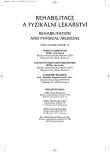Possibilities of the Preparation Geladrink Fast in Patients with Discopathy
Authors:
J. Vacek 1; M. Pohanka 2
Authors‘ workplace:
Katedra rehabilitační a fyzikální medicíny IPVZ, Praha
1; Klinika funkční diagnostiky a rehabilitace LF MU, Brno
2
Published in:
Rehabil. fyz. Lék., 15, 2008, No. 2, pp. 90-94.
Category:
Original Papers
Overview
Character of the study:
A pilot project.
Objective:
To verify the influence of a rest regimen together with the nutritional supplement Geladrink Fast in patients with acute attack of painful syndrome in lumbodorsal region with verified discopathy.
Methods:
15 patients without any other pharmaceutical or physical therapy used the preparation Geladrink Fast according to the manufacturer’s recommendation. The evaluation of the pain was on a ten-degree pain scale.
Results:
In 9 p0atienbts there was decrease of pain by 2-3 degrees.
Conclusion:
The preparation Geladrink Fast may play a role as a useful supplement of other kinds of treatment in patients with discopathy.
Key words:
low back pain, pharmaceutical therapy, degenerative therapy, prolapsed matter, central sensitization
Sources
1. OLMAKER, K., RYDEVIK, B.,NORDBORG, C.: Autologous nucleus pulposus induces neurophysiologic and histologic changes in porcine cauda equina nerve roots. Spine, 18, 1993, s. 1425-1432.
2.. MCCARRON, R. F.,WIMPEE, M. W., HUDKINS, P. G. et al.: The inflamatory effect of nucleus pulposus: a possible element in the pathogenesis of low-back pain. Spine, 12, 1987, s. 760-764.
3. GELADRINK Forte® u pacientů s gonartrózou dvojitě slepá, randomizovaná, placebem kontrolovaná, multicentrická studie. K. Pavelka, R. Bečvář, J. Böhmová, Z. Dvořák, K. Šírová, Z. Urbanová, V. Vlasáková, J. Gatterová, H. Hulejová.
4. HUNT, J. L, WINKELSTEIN, B. A , RUTKOWSKI, M. D, EINSTEIN, J. N., DELEO, J. A.: Repeated injury to the Lumbar nerve roots produces enhanced mechanical allodynia and persistent spinal neuroinflammation. Spine, 26, 2001, s. 2073-2079.
5. LUOMA, K., RIIHIMÄKI, H., LUUKKONEN, R., RAININKO, R., VIIKARI-JUNTURA, E., LAMMINEN, A.: Low back pain in relation to lumbar disc degeneration. Spine, 25, 2000, s. 487-492.
6. ORVEME, Jr T. R., JOHNSON, S. L., AGUIAR, D. J, OGILVIE, J. W.: Fibronectin and Its fragments increase with degeneration in the human intervertebral disc. Spine, 25, 2000, s. 2742-2747.
7. BUCKNILL, A. T, COWARD, K, PLUMPTON, CH., TATE, S.,BOUNTRA, CH., BIÍCH, R., SANDISSON, A, HUGHES, S. P. F, NAND, P.: Nerve fibres in lumbar spine structures and injured spinal roots express the sensory neuron-specific sodium channels SNS/PN3 and NaN/SNS2. Spine, 27, 2002, s. 135-140.
8. McCARRON, R. F.,WIMPEE M. W., HUDKINS, P. G. et al.: The inflamatory effect of nucleus pulposus: a possible element in the pathogenesis of low-back pain. Spine, 12, 1987, s. 760-764.
9. OZAWA, K., ATSUTA, Y, KATO, T.: Chronic effect of the nucleus pulposus applied to nerve roots on ectopic firing and conduction velocity. Spine, 26, 2001, s. 2661-2665.
10. Award-Winning Study Highlights a Biological Trigger For Nerve Damage Following a Disc Herniation. The Back letter,. 15, 2000, s. 73-80. Lippincot Williams and Wilkins.
11. HORNER, H. A, URBAN, J. P. G.: Volvo award winner in basic science studies: Effect of nutrient supply on the viability of cells from the nucleus pulposus of the intervertebral disc. Spine, 26, 2001, s. 2543-2549.
12. HORNER, H. A, URBAN, J. P. G.: Volvo award winner in basic science studies: Effect of nutrient supply on the viability of cells from the nucleus pulposus of the intervertebral disc. Spine, 26, 2001, s. 2543-2549.
13. OLMAKER, K., RYDEVIK, B., NORDBOR,C.: Autologous nucleus pulposus induces neurophysiologic and histologic changes in porcine cauda equina nerve roots. Spine, 18, 1993, s. 1425-1432.
14. OLMAKER, K., NORDBORG, C., LARSSON, K. et al.: Ultrastructural changes in spinal nerve roots induced by autologous nucleus pulposus. Spine, 21, 1996, s. 411-414.
15. KAWAKAMI, M.,TAMAKI, T.,HAXASHI, N. et al.: Possible mechanism of painful radiculopathy in lumbar disc herniation.Clin. Orthop., 351, 1998, s. 241-251.
Labels
Physiotherapist, university degree Rehabilitation Sports medicineArticle was published in
Rehabilitation & Physical Medicine

2008 Issue 2
- Hope Awakens with Early Diagnosis of Parkinson's Disease Based on Skin Odor
- Deep stimulation of the globus pallidus improved clinical symptoms in a patient with refractory parkinsonism and genetic mutation
Most read in this issue
- Natural Treatment Sources in the Czech Republic
- New Aspects in the Roswitha Brunkow Method by Following the Activity of Selected Muscles by EMG
- Myths about the Stabilization System
- The Comparison of Functional Foot Types Occurrence in Men and Women
